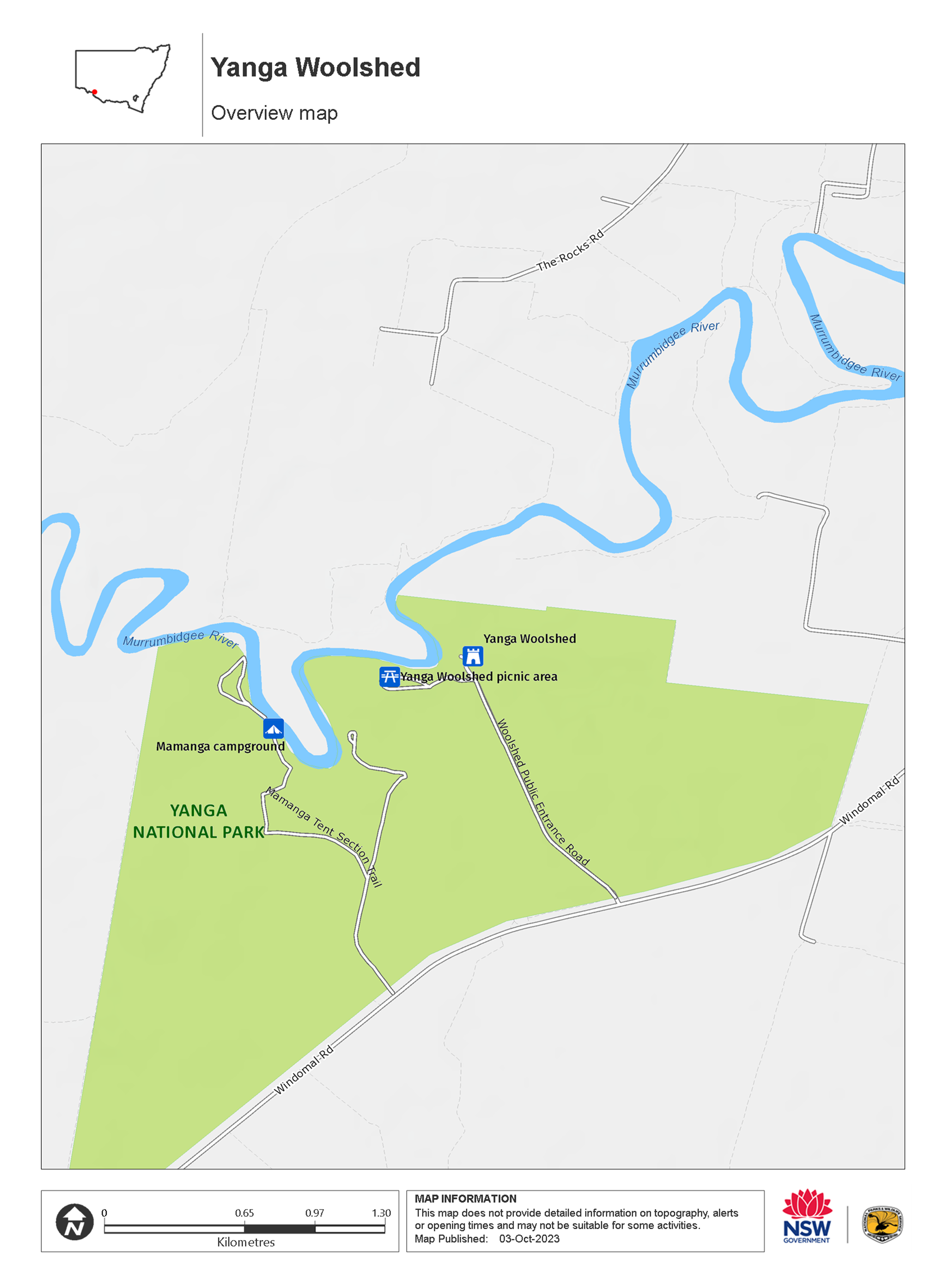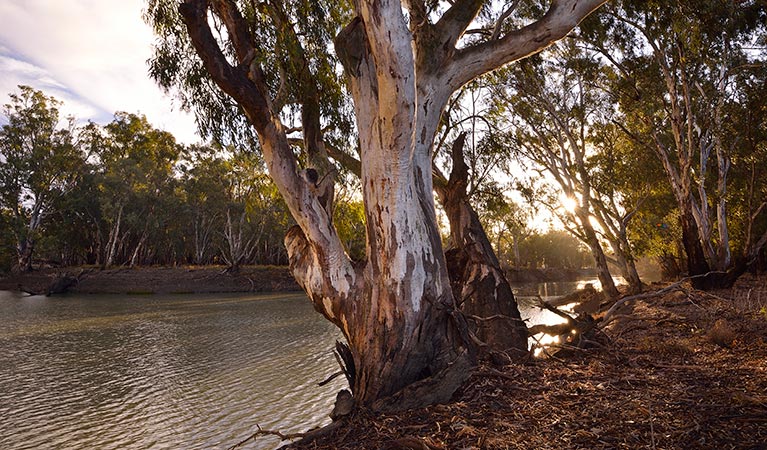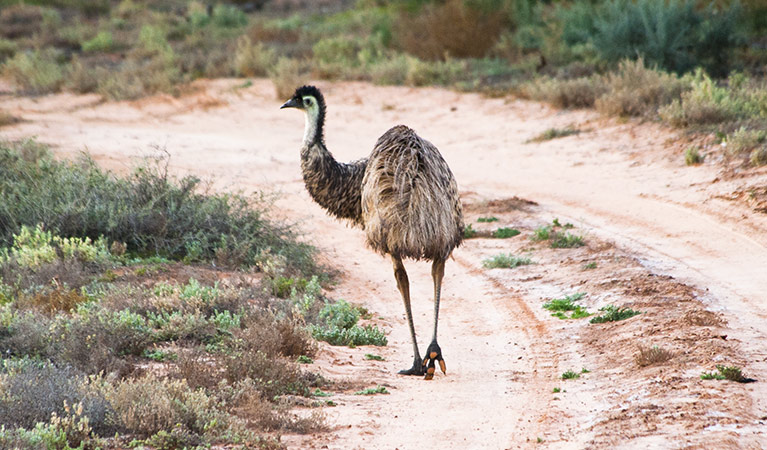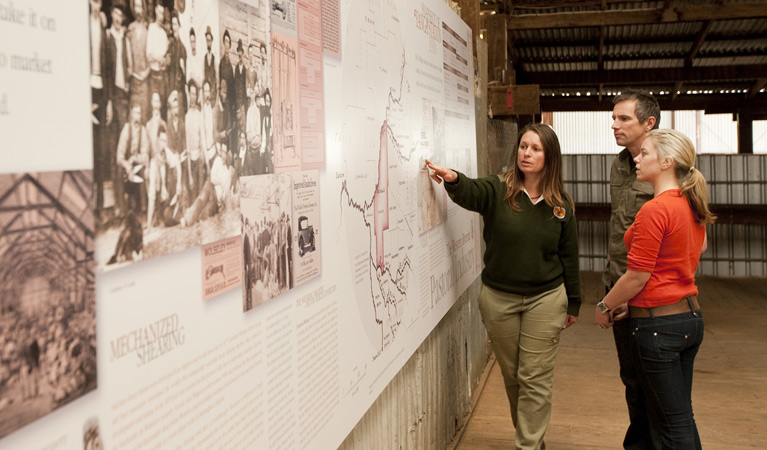Yanga Woolshed
Yanga National Park
Overview
Explore Yanga Woolshed in Yanga National Park. When constructed in the late 1800s, the woolshed was the Riverina’s largest. It offers an insight into Australia’s pastoral history.
- Type
- Historic buildings/places
- Where
- 312 Windomal Road, Balranald, NSW, 2715 - in Yanga National Park in Murray-Riverina
- Accessibility
- Medium
- What to
bring - Drinking water
- Hire this venue
Yanga Woolshed is available for events and function hire.
- Please note
Water is not available at Yanga Woolshed.
Located along Murrumbidgee River, Yanga Woolshed was built in the late 1800s. Once the largest, most modern woolshed in the district, it housed 3,000 sheep and provided work for up to 40 shearers at a time.
Today, the woolshed is in Yanga National Park and you can wander through it on a self-guided tour, exploring its runs and pens, getting a feel for an authentic 19th century woolshed and a taste of Australian history.
You’ll also find an interpretive display to fill you in on the history of the area – once Yanga Sheep Station. Close your eyes and breathe in the smells of the past, imagining the sounds of docked paddle boats outside, waiting to transport their wool cargo down the river highway.
Don’t forget to check out the viewing platform for great river views; it was once where the old wharf stood. Pack lunch and visit the nearby Yanga Woolshed picnic area or stay overnight at Mamanga campground.
Yanga Woolshed is also available for weddings and private functions.
Map

Map legend

Local alerts
For the latest updates on fires, closures and other alerts in this area, see https://www.nationalparks.nsw.gov.au/things-to-do/historic-buildings-places/yanga-woolshed/local-alerts
General enquiries
- National Parks Contact Centre
- 7am to 7pm daily
- 1300 072 757 (13000 PARKS) for the cost of a local call within Australia excluding mobiles
- parks.info@environment.nsw.gov.au
Park info
- in Yanga National Park in the Murray-Riverina region
Yanga National Park is open Sunrise to Sunset but may have to close at times due to poor weather or fire danger.
Yanga Homestead Precinct is open 8.30am - 4.30pm.
Visitor info
All the practical information you need to know about Yanga Woolshed.
Maps and downloads
Learn more
Yanga Woolshed is in Yanga National Park. Here are just some of the reasons why this park is special:
A pioneering history

Some of the country's renowned early explorers passed through this area, and you have the opportunity to retrace their steps. Explorers included John Oxley in 1817, Charles Sturt in 1830, Major Thomas Mitchell in 1836 and Burke and Wills in 1860. Visit nearby Balranald to see where Bourke and Wills' party crossed the Murrumbidgee by the Mayall Street punt, then camped by the river in front of Balranald Inn.
- Yanga Woolshed Explore Yanga Woolshed in Yanga National Park. When constructed in the late 1800s, the woolshed was the Riverina’s largest. It offers an insight into Australia’s pastoral history.
- Yanga Woolshed picnic area Located in Yanga National Park, near Balranald in the Riverina, Yanga Woolshed picnic area is an excellent place for a barbecue or spot of fishing on the Murrumbidgee.
A remarkable landscape

Yanga National Park is blessed with 170km of Murrumbidgee River frontage. The river is great for canoeing or swimming, and its banks provide excellent fishing and camping spots. On your visit, you'll notice the landscape's unique contrast of black and red country. Vegetation on its black soil floodplains comprises river red gum forest and swampland, while its red soil varies from grass to saltbush to woodlands. Come and spot the differences yourself.
- Regatta Beach picnic area Enjoy swimming, boating, birdwatching and paddling in the tranquil lakeside waters of picturesque Regatta Beach picnic area in Yanga National Park, near Balranald.
Rich in Aboriginal culture

Yanga National Park has a rich Aboriginal history; the park provided resources including waterbirds, fish, and yabbies as well as shelter and medicine. Look closely at the trees in the floodplain where you're visiting – many bear the bark-stripping scars from canoe-making. Today, local Aboriginal people remain connected with Yanga National Park through employment or community involvement.
- Yanga Lake viewing deck Yanga Lake viewing deck offers spectacular birdwatching and scenic wetland views in Yanga National Park, near Balranald.
Unbeatable for birdwatchers

A large number of migratory birds rely on the Yanga National Park red gum wetlands. The park is a great place to see egrets, herons, spoonbills and glossy ibis using the wetlands as a resting, foraging and breeding ground. Walk to the bird hide at Yanga Lake to see great crested grebes and sea eagles. The park is also home to the endangered southern bell frog. This frog's calls' are said to resemble a distant motorbike – listen carefully to see if you can hear it.
- Yanga Lake paddle Kayak Yanga Lake for an outback experience like no other. Wonder at the vast sky reflected in 1200ha of water, and spot wildlife and birds drawn to the wetlands in Yanga National Park.
- Yanga Lake Red Gum bird hide All the family will enjoy spectacular birdwatching and scenic views at Yanga Lake Red Gum bird hide in Yanga National Park near Balranald.
- Yanga Lake walking track Short yet rewarding, Yanga Lake walking track is a family friendly lakeside walk offering scenic wetlands views and spectacular birdwatching in Yanga National Park.
Plants and animals protected in this park
Animals
-

Southern boobook (Ninox novaeseelandiae)
The southern boobook, also known as the mopoke, is the smallest and most common native owl in Australia. With a musical 'boo-book' call that echoes through forests and woodlands, the southern boobook is a great one to look out for while bird watching.
-

Common ringtail possum (Pseudocheirus peregrinus)
Commonly found in forests, woodlands and leafy gardens across eastern NSW, the Australian ringtail possum is a tree-dwelling marsupial. With a powerful tail perfectly adapted to grasp objects, it forages in trees for eucalypt leaves, flowers and fruit.
-

Kookaburra (Dacelo novaeguineae)
Of the 2 species of kookaburra found in Australia, the laughing kookaburra is the best-known and the largest of the native kingfishers. With its distinctive riotous call, the laughing kookaburra is commonly heard in open woodlands and forests throughout NSW national parks, making these ideal spots for bird watching.
Plants
-

River red gum (Eucalpytus camaldulensis)
Australian native plants, majestic river red gum trees are widespread across Australian inland river systems. The river red gum is a dominant tree species of the Murray-Darling basin which spans NSW, Queensland and Victoria. This iconic native eucalypt grows to a height of 30m and is thought to have a lifespan up to 500-1000 years.
-

Saltbush (Atriplex nummularia)
A hardy Australian native plant, the saltbush is a small spreading shrub that can withstand dry salty soils such as those found in the desert plains of western NSW. It is grey-white in colour and has small spear-shaped succulent leaves. It flowers from December to April.

